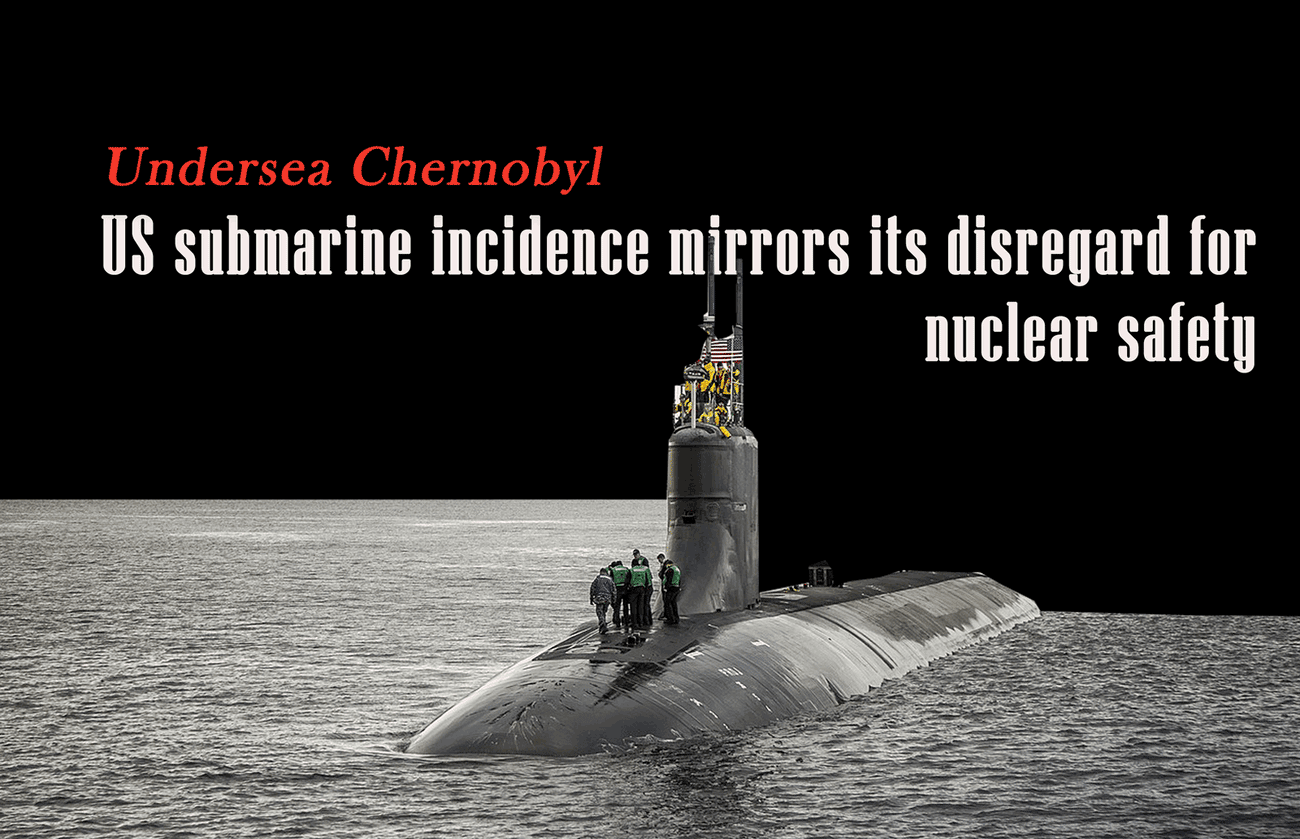US submarine incidence example of the superpower’s reckless military presence

Illustration/People's Daily Online
Roughly a month ago, the USS Connecticut, a nuclear-powered attack submarine operated by the US Navy, smashed itself into an “unknown object” in the South China Sea, sending shock waves throughout the region and beyond. Days after the collision, two anonymous officials disclosed that a seamount was suspected as the “object” that the Connecticut collided with, and that the wounded ship, which had limped back to Guam, awaited further assessment. But no additional information on exactly when, where, and how the accident occurred and what damage it might have caused has resurfaced ever since.
[Related Reading: US submarine collision raises red flag on maritime security]
The episode has strained the nerves of the international community and has generated a sense of déjà vu at home and abroad, because the US has been no stranger to similar incidents, with many of its submarine disasters dating back to as early as the 1960s .
On April 10, 1963, the USS Thresher, then one of the world’s most advanced nuclear-powered submarines, sank during its diving tests southeast of Cape Cod, killing all 129 personnel on board. Only five years later, another nuclear-powered sub—the USS Scorpion—failed to surface, together with all 99 crew members on board. In December 1977, the USS S-4, then a first-class submarine operating in the American fleet, collided with a US Coast Guard cutter before sinking and claiming the lives of 38 personnel.
American-style recklessness seems to not only be an intrinsic quality that the US Navy has inherited in its history of submarine operations, so is its apparent lack of transparency.
After more than a half-century since the sinking of the USS Thresher, which remains the deadliest submarine accident in human history, its root cause still remained shrouded in mystery. It was only in 2019 when relevant documents were ordered to be declassified after a prolonged lawsuit, which finally permitted the public to learn about the true fate of the sunken vessel, the tragedy having been a product of a failed seawater pipe in the submarine.
Now came the USS Connecticut accident, in which the US media would rather accuse other nations of making an undue fuss about a nuclear sub accident at their doorsteps rather than pressing the US Navy to clarify further details on the collision in a timely and responsible manner. On October 27, the Business Insider published an article entitled “China is fixated on a mysterious US submarine incident in the South China Sea and keeps accusing the US of a cover-up”, in which the news website cited a Pentagon statement, a document that amounted to nothing else but a blank sheet of paper purporting to show useful information, calling it evidence of the country’s so-called “transparency.”
But if there is evidence of anything, then the evidence is on the surface and below the vast ocean where the US has kept its far-reaching and menacing military presence, with the thing being its relentless efforts in stirring up tension and unrest. For years, if not decades, the US has carried on its despicable mission of trespassing and scouting around in the South China Sea. In 2021 alone, US aircraft carriers have entered the region as many as nine times, with its swarms of reconnaissance aircraft buzzing above the water 24/7.
The consequences are discernible: apart from heightened tensions that are being unilaterally provoked by the US, the superpower has also inflicted upon itself a self-fulfilling paranoia and, with it, has successfully given rise to a vicious circle of a heightened arms race (including Australia’s most recent shopping frenzy for nuclear subs).
Apart from other types of weapons, which the US has never hesitated to deploy or sell even though they sometimes directly lead to civilian deaths (which the US often refers to as “collateral damage”), nuclear-powered submarines have a distinctive dark side.
A nuclear-powered submarine by definition is a submarine fueled by nuclear reactors. It is sometimes hyperbolically dubbed as “an atomic bomb waiting to explode” or a “moving Chernobyl”—and for good reasons. Although a reactor accident within a submarine isn’t tantamount to a nuclear explosion, it can potentially release a large amount of radioactivity into the ocean, resulting in horrendous environmental hazards.
Now, with the freshly signed AUKUS, a trilateral deal in which the US and UK will help Australia to acquire submarines powered with highly enriched uranium, the occurrence of nuclear sub-related accidents, the environmental hazards such accidents may bring about, together with their adverse impacts on the global drive for non-proliferation will undeniably be multiplied.
Imagine just one nuclear submarine dashing around in the ocean. And then imagine similar nuclear subs but in droves, in fleets, belonging to a mix of nations. Even when all is calm, they can still self-destruct in a collision with an “unknown object,” while in more troubled waters, they may actually be considered more or less equivalent to a moving peril.
Another byproduct of the omnipresence of US nuclear submarines is that they sway other countries’ trust (if there is any) in the superpower’s sincere desires to denuclearize Iran and DPRK. Much like America’s abandonment of the hard-won Iran nuclear deal won’t persuade nations elsewhere to stop developing nuclear technologies of their own, neither will America’s decision to sell and deploy nuclear submarines help nations ease their nerves and defensive reflexes.
By leading nuclear submarines into the South China Sea and covering up accidents of any kind, the US is jeopardizing global efforts to transform the region into one of its Nuclear-Weapon-Free Zones, opening up the Pandora’s box of a post-Cold War arms race, while endangering the world’s non-proliferation mission. The entire Asia-Pacific region also risks being reduced into one of America’s geopolitical toolboxes, from which it continues to profit lucratively by means of selling weapons that now include nuclear-powered attack submarines.
This week, during his trip to Europe to attend the G20 summit and a UN climate summit, American President Joe Biden may choose to embrace any of the three knottiest issues that have appeared during his long career, all of which require a whole lot of explanation: 1) explain to his French counterparts why the US stabbed France in the back and stole its ally’s submarine deal; 2) explain to Iran and all relevant parties why America should be trusted after its flip-flopping on the Iran nuclear deal; and, 3) convince the world that the US is consistent in its climate policies and that it can be relied upon to lead the global emissions reduction cause. With the latest episodes involving US nuclear subs, which will undoubtedly cast a shadow over Biden’s trip, and given America’s consistently terrible record in safeguarding global norms and international security, any concerns that arise about the trustworthiness of the world’s only superpower won’t be a surprising outcome.
Photos
Related Stories
- Collision of USS Connecticut in South China Sea exposes severe security risks
- US submarine collision raises red flag on maritime security
- China urges U.S. to clarify nuclear submarine incident
- Indonesian Army detects underwater movement at last location of missing submarine
- Indonesian submarine with over 50 aboard feared sunken: local media
Copyright © 2021 People's Daily Online. All Rights Reserved.










